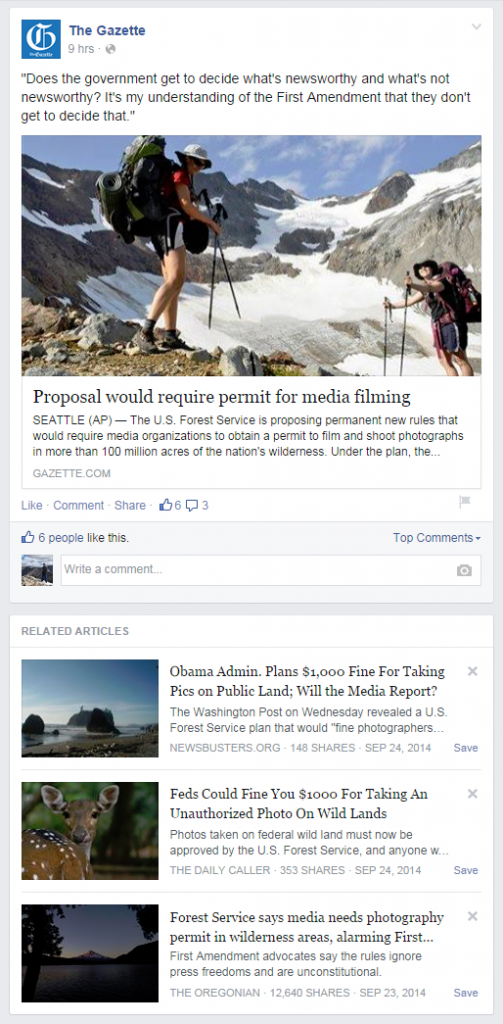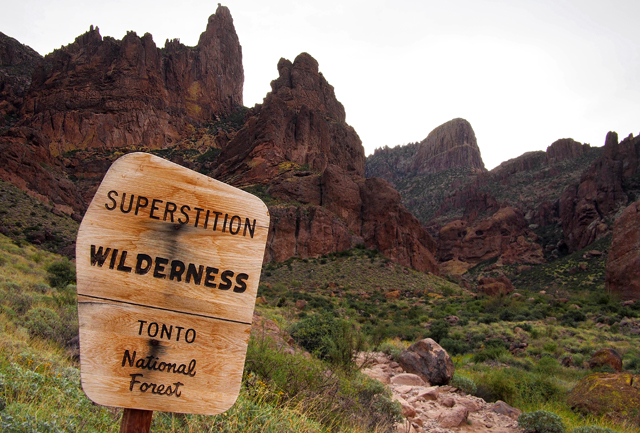With many ways to sell a story, marketing outrage is a viable option. People seem to like getting emotionally engaged, charged up, fired up, even outraged. We can’t resist.
Here’s an example.
One story positioned with four different headlines in this screen capture from my Facebook news feed yesterday.
Which Organization is Marketing Outrage?
>
Can you locate the organization that’s opting to market outrage?
1 The Gazette, Colorado Springs: “Proposal would require permit for media filming”
2 NewsBusters.org: “Obama Admin. Plans $1,000 Fine for Taking Pics on Public Land; Will the Media Report?”
3 The Daily Caller: “Feds Could Fine You $1000 For Taking An Unauthorized Photo On Wild Lands”
4 The Oregonian: “Forest Service says media needs photography permit in wilderness areas, alarming First Amendment advocates”
For failing to identify the limits of the proposal and for allowing individuals to fear for their freedoms, The Daily Caller is my runner up.
The winner, of course, is NewsBusters.org, for both taking blame straight to Obama and for suggesting that the media will cover it up. The sadness, hilarity, and irony of their emotionally charged headline was that it was wrapped in … media reports. No conspiracy. No cover up.
What’s the Story?
You can click through the posts above – or here – for the specifics of this story about commercial photography and videography in wilderness areas.
The story is interesting and consequential for a variety of reasons: who’s media, what’s commercial, what’s journalism, who approves, on what grounds, why’s a permit fee greater than a fine, where’s the slippery slope, whose land is it anyway, what about free speech?
You can click here and see the federal register detailing the proposal, which is still open for public comment.
Here, though, is a story above the story. Though the situation itself might inspire outrage, the positioning of it shouldn’t.
The Associated Press is a service to which many news organizations subscribe to provide news content like this; it’s one of the reasons so much news feels so homogeneous.
What struck me when all four headlines were presented adjacent to one another in my news feed, then, was the variety of ways a simple AP story was positioned.
The fourth provided the most information in the headline, identifying the authority, the media, and the land. They did take care to assign concern over the proposal, so it’s not free of emotion or bias.
The first was the least charged, but also the most bland. They didn’t identify the authority or the land, but made clear that the average citizen would not be affected.
The third steps it up a notch by identifying “Feds” and failing to identify the media. This could happen to YOU!
The second, as described above, went all in on outrage. That damned Obama again trying to take away your rights … and the press he has in his back pocket won’t even cover it! Emotion! Outrage! Fear!
Unfortunately, news and opinion peddlers do this because it works. We prefer emotion. And emotion is far more useful for moving people than reason. Winning hearts is more effective than winning minds in many cases.
And it’s all trackable. Again, they wouldn’t do this if it didn’t work. They know exactly which headlines are effective because they can track every click. If we weren’t responding to negative emotion through our behavior (clicking through), they’d tone it down.
Finally, it’s marketing and even branding. You can make basic and fair judgments about each organization based on the way they positioned this AP story. How they position the story says something about who they are – and who you are, to the degree you identify with the positioning.
The Bottom Line
Try not to feed those marketing outrage. Try not to give into emotion and click their links.
Not one of us needs more negative emotion in our lives; we get enough of it every election cycle.
Also
For a look at the Superstition Wilderness near Apache Junction, Arizona, click here or here.

Spot on! Great read. I was just thinking the same thoughts yesterday as I kept seeing the article in my news feed. I knew for sure that almost none of those people actually read or understand the issue.